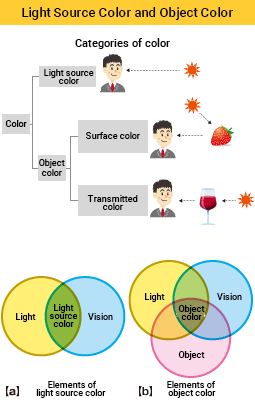Theory of Light and Color

12. Color (Part 2) Objects Have No Color
Light Source Color and Object Color
In the last chapter, we described how light and sight are the minimum requirements for color to exist.
There are two broad categories of color: light source color and object color. Light source color comes from light directly entering the eye from a light source. Object color comes from light that enters the eye after interacting with an object, so it depends on an object's reflection/transmission properties at each wavelength. Within object color, there are surface colors and transmitted colors. The surface color comes from reflection off the object's surface. Transmitted color comes from light passing through a translucent object.
Only light source color is visible under the two conditions of light and vision alone (Figure [a]). We often perceive different colors depending on the type of light source. Candles are close to red, and mercury lamps look bluish-white. The sodium lamps used in tunnels look orange. All these light sources have distinct energy levels (spectral distribution) at each wavelength, so the strength of the stimulus to photoreceptors (cone cells) is different. That is why they look different in color.

Example Spectral Distributions of Various White Light Sources

Most of the colors we see are object colors. The characteristics of the object itself determine its color, which is why different objects have distinct colors even under the same illumination. As shown in Figure [b], the final color of an object is where light, sight, and object overlap. These are the three elements of object color.
Why a Strawberry and a Lemon Have Different Colors
When light hits an object, some wavelengths reflect, and others are absorbed. This spectral reflectance property ≪1≫ depends on the object, so they have different colors even under the same light.
Compare the spectral reflectance of a strawberry and a lemon. Both reflect most long wavelengths (red) in the visible range and absorb most short wavelengths (blue). However, their properties differ in middle wavelengths (green).
A strawberry reflects most long wavelengths and absorbs the short and middle wavelengths. Under white light, the long wavelengths that enter the eye stimulate the L-cones but not the S- and M-cones. As a result, the strawberry appears red.
On the other hand, a lemon reflects middle and long wavelengths but not short wavelengths. It stimulates L-cones the most and partly the M-cones. As a result, we perceive lemons as yellow, an additive mixture of red and green.
In the end, the color of an object is determined by a combination of the properties of a light source (spectral distribution), object (spectral reflectance or spectral transmittance), and sight (photoreceptor).

An Object Itself Has No Color
The color of an object will change if even one of the three elements of object color changes. The light source and the vision are indispensable for color to exist, and the object changes the light source color.

The above is a case of using white light like sunlight, which has energy distributed across the visual spectrum. But what happens if we use a monochromatic light instead of white light?
Red LED Illumination
The strawberry and the lemon look bright red because they have a high reflectance in the long-wavelength range.
A red LED only emits longer wavelengths, so the spectral reflectance of the strawberry and the lemon at short and middle wavelengths has no impact.

Blue LED Illumination
The strawberry and the lemon appear dark since they have very low reflectance in the short-wavelength range. Most of the blue light is absorbed with little to no reflection.
The blue LED emits only short-wavelength light. Whether the strawberry and lemon have high or low reflectance in the middle- and long-wavelength ranges does not matter.

Green LED Illumination
The green LED only has middle-wavelength light. In contrast to the bright green lemon, the strawberry appears dark green. The lemon reflects more light since it has higher reflectance in that range of the visible spectrum than the strawberry.


The above shows that an object itself does not have color. It is similar to how a dress color looks different at a department store compared to at home or under sunlight. The spectral distribution of the light source is different, even though the dress and the observer are the same.
Comment
≪1≫ Reflectance
The reflectance of a material surface is the ratio of the reflected radiant flux or luminous flux to the incident radiant flux or luminous flux (JIS Z 8113: 1998).
Reflectance encompasses all the reflected luminous flux reflected in various directions. On the other hand, you only see the reflected luminous flux coming into your eye. So technically speaking, the correct term is luminance factor instead of reflectance.
Luminance factor is the ratio of the luminance (radiance) to the luminance (radiance) of a perfect diffuse reflector (JIS Z 8113: 1998). Per the definition of luminance, the angle of view is a specified condition.
Since luminance factor is not as widely understood, we use the term "spectral reflectance property" even though it is technically inaccurate.

